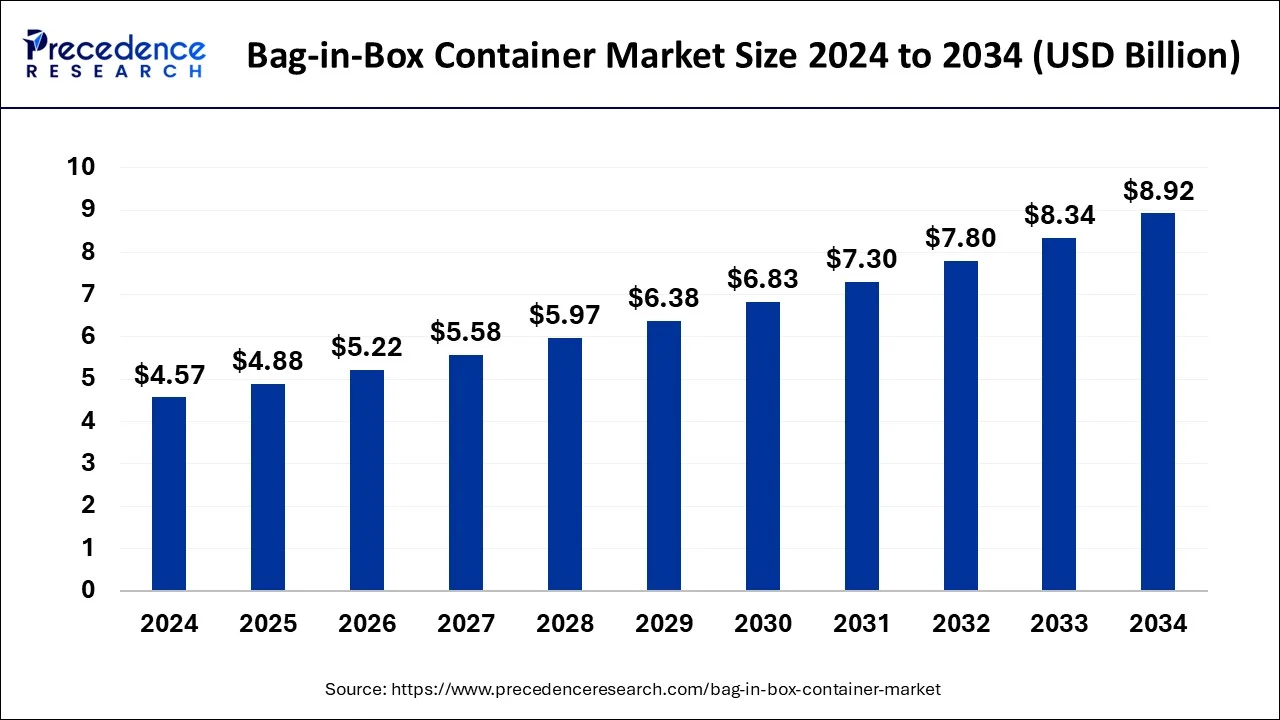The global bag-in-box container market is set to grow from USD 4.57 billion in 2024 to USD 8.92 billion by 2034, at a CAGR of 6.93%

Bag-in-Box Container Market Key Takeaways
- Europe led the bag-in-box container market with a 44% share in 2024.
- Asia Pacific is expected to grow at the fastest CAGR from 2025 to 2034.
- The food and beverage segment accounted for more than 66% of market revenue in 2024.
- Ethylene vinyl alcohol and low-density polyethylene emerged as profitable market segments in 2024.
Market Overview
The bag-in-box container market is experiencing significant growth due to its increasing adoption across various industries, including food and beverage, pharmaceuticals, and household products. This packaging solution offers advantages such as extended shelf life, reduced storage space, and lower transportation costs. The growing demand for sustainable and eco-friendly packaging alternatives has further fueled the market expansion. Additionally, advancements in material technology, including ethylene vinyl alcohol (EVOH) and low-density polyethylene (LDPE), have improved the durability and efficiency of bag-in-box containers, making them a preferred choice for liquid and semi-liquid products.
Drivers
One of the primary drivers of the bag-in-box container market is the rising demand for cost-effective and lightweight packaging solutions. The food and beverage industry, which holds a significant market share, is increasingly adopting this packaging format for wine, dairy products, and non-alcoholic beverages. Additionally, the focus on sustainability and reducing plastic waste has led manufacturers to develop recyclable and biodegradable materials, further propelling market growth. The expanding e-commerce sector is also driving demand, as bag-in-box containers provide spill-proof and durable packaging for liquid products during transportation.
Opportunities
The market presents numerous opportunities, particularly in emerging economies where the demand for convenient and innovative packaging solutions is increasing. Asia Pacific, in particular, is expected to witness the highest growth rate due to rising disposable incomes and urbanization. The shift toward plant-based and organic beverages is also creating new avenues for the bag-in-box container market, as these products require efficient and hygienic packaging. Furthermore, ongoing technological advancements in aseptic packaging and smart packaging solutions are opening doors for enhanced product offerings and extended shelf life.
Challenges
Despite its promising growth, the bag-in-box container market faces certain challenges. One of the key hurdles is the high initial investment required for manufacturing and packaging machinery. Additionally, concerns regarding the recyclability of multi-layered plastic materials used in bag-in-box packaging pose regulatory and environmental challenges. The market also faces competition from traditional rigid packaging formats, which are still widely used in various industries. Moreover, fluctuations in raw material prices, particularly for plastic and barrier films, may impact production costs and overall profitability.
Regional Insights
Europe currently dominates the bag-in-box container market, holding the largest market share due to the region’s strong emphasis on sustainable packaging solutions. Stringent regulations regarding plastic usage and waste management have encouraged the adoption of bag-in-box packaging in industries such as food and beverage, cosmetics, and chemicals. North America follows closely, driven by increasing demand for bulk liquid packaging solutions in the beverage industry. Meanwhile, Asia Pacific is anticipated to grow at the fastest CAGR over the forecast period, supported by rapid industrialization, expanding retail networks, and the rising popularity of ready-to-drink beverages. Latin America and the Middle East & Africa are also witnessing steady growth, particularly in the food and pharmaceutical sectors.
Recent News
The bag-in-box container market has been witnessing significant developments, with major players focusing on product innovation and strategic collaborations. Several manufacturers are launching recyclable and biodegradable bag-in-box solutions to cater to the growing demand for sustainable packaging. Additionally, partnerships between packaging companies and beverage manufacturers are leading to the development of customized packaging solutions that enhance convenience and product longevity. Technological advancements in dispensing systems and smart packaging, such as QR codes for tracking and authentication, are also shaping the future of the industry. As companies continue to invest in research and development, the market is expected to evolve with more advanced and eco-friendly packaging solutions.
Bag-in-Box Container Market Companies
- Scholle IPN
- DS Smith
- Liqui-Box
- CDF Corporation
- Parish Manufacturing Inc.
- Amcor Limited
- Vine Valley Ventures LLC
- Smurfit Kappa Group
- Optopack Ltd
- TPS Rental Systems Ltd.
- Others
Segments Covered in the Report
By Type
- Ethylene Vinyl Alcohol
- Low-Density Polyethylene
- Ethylene Vinyl Acetate
- Others
By Application
- Industrial Liquids
- Petroleum Products
- Oils
- Industrial Fluids
- Household Products
- Liquid Detergents
- Household Cleaners
- Food & Beverages
- Alcoholic Beverages
- Beer
- Wine
- Others
- Nonalcoholic Beverages
- Flavored Drinks
- Soft Drinks
- Others
- Others
- Milk & Dairy Products
- Edible Oil
- Others
- Alcoholic Beverages
By Regional Outlook
- North America
- U.S.
- Canada
- Europe
- U.K.
- Germany
- France
- Asia Pacific
- China
- India
- Japan
- South Korea
- Middle East & Africa
- Latin America